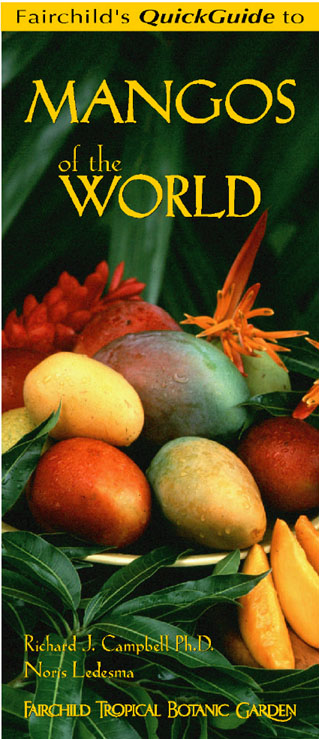Farchild Tropical Gardens
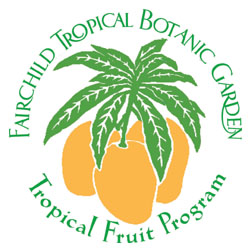
Mango Cultivars
Richard J. Campbell, Ph.D.
Senior Curator of Tropical Fruit
The first in the new QuickGuide series, Fairchild’s QuickGuide to Mangos of the World has practical information on over 60 mango cultivars. Whether you’re a mango aficionado or a new home grower, the Mangos of the World will quickly provide you hands-on information on height, fruiting season and more.
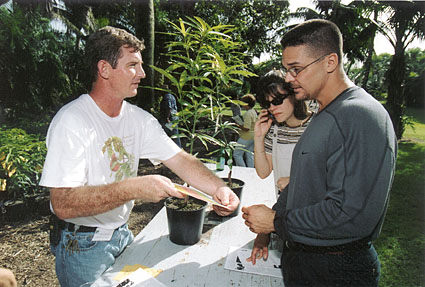
| Picture | Origin |
Name |
Description |
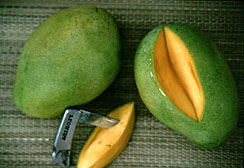 |
India | Alampur Baneshan | ‘Alampur Baneshan’ originated in the Andhra Pradesh region of North India and is considered as one of the finest dessert mangos in the country. The fruit are large, averaging 14 to 16 oz. They are oblique-oblong. The skin color is green, even when ripe, and is overlaid with characteristic corky dots covering the fruit surface. As with most other fine dessert mangos of India, ‘Alampur Baneshan’ is best harvested hard-green and ripened at room temperature. In this manner one can expect an exceptional, multi-leveled flavor, from the deep and resinous to the intensely sweet. This is a mango for the true connoisseur, not the beginner, as its flavor could prove to be overpowering to the unaccustomed palate. The fruit are uncommon outside of India and due to its green skin color, yield limitations and propensity for pre-harvest splitting, it is improbable that they will enter into international export markets. |
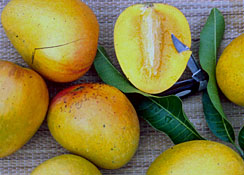 |
India | Alphonse | ‘Alphonse’, often termed ‘Alphonso’, is among the finest of Indian dessert mangos. Originating in Goa, ‘Alphonse’ weighs 10 oz, with an ovate-oblique shape. The fruit can be green or a bright yellow depending on the environmental conditions, and they often have a pink blush on the sun-exposed shoulder. The ripening fruit are the perfect accent for the kitchen, perfuming the air with a wonderful sweet and fruity aroma. The flavor also is intensely sweet, rich and full, with multiple aromatic overtones and a hint of citrus. There is no fiber in the orange, melting flesh. ‘Alphonse’ is best eaten out-of-hand, and is exported from India to specialty markets in Europe, where it is sold for a good price. The fruit are harvested firm, at the mature green stage, and are not refrigerated prior to ripening. Mature-green fruit are ripened at 70F to develop optimal flesh texture, flavor and aroma. |
| Bailey’s Marvel | ‘Bailey’s Marvel’, a mid-season cultivar with large, colorful fruit and an excellent flavor | ||
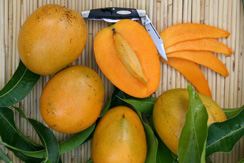 |
Haiti | Baptiste | ‘Baptiste’ was selected in Haiti, where it is grown on a locally commercial scale. The fruit are oval, with a smooth, non-waxy skin, weighing from 8 to 16 oz. They are bright yellow to orange and are exceptionally firm, with surprisingly little fiber. The flesh is a deep orange, with a mild and sweet flavor. ‘Baptiste’ is popular in Haiti, and can be found in local markets, but it is mostly unknown outside of the island. The tree is ease to manage for size and has characteristically small leaves with a light green color. The tree and fruit are moderately susceptible to anthracnose infection. The firm flesh holds its shape upon cutting, which suits it well for fruit salads and for cooking. |
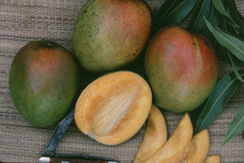 |
Jamaica | Bombay | ‘Bombay’ is a traditional variety from Jamaica. As the name would suggest, it originated from seeds brought to the island by early immigrants from India, and the fruit and tree are similar in shape, taste and habit to the ‘Paheri’ of India. The fruit range from 12 to 14 oz. and remain a deep green color even when ready to eat. When exposed to the sun they often develop a dull red shoulder. The flesh is a deep orange, melting and juicy with no hint of fiber. The flavor is rich and spicy, reminiscent of the finest of the Indian dessert types. The tree is vigorous, open growing and forms a large, handsome tree. This particular selection was handpicked for consistent fruiting under South Florida conditions. The fruit can be cut around the middle, twisted to separate into two halves and eaten with a spoon. |
| Carrie | A home garden favorite offering small tree size, disease tolerance and excellent flavor | ||
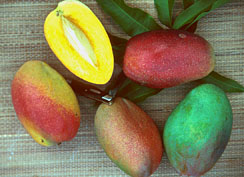 |
Florida | Cogshall | ‘Cogshall’, selected on Pine Island, Florida in the 1940s, is recognized for its small tree size, heavy production, eating quality and beauty. The fruit, averaging about a pound, have eye-catching yellowish-orange skin, overlaid with a brilliant crimson blush. The soft, completely fiberless flesh is aromatic, with a rich, spicy flavor that is sure to please. Both fruit and tree have good disease tolerance. The fruit ripen like jewels, a few each day, over an extended season from mid June through July. The ‘Cogshall’ tree remains compact; with minimal pruning it can be maintained at a height and spread of six feet or less while producing 30 to 50 pounds (3 to 5 boxes) of fruit. |
| Cushman | grapefruit shape and sweet flavor | ||
| Dot | yellow color and excellent flavor | ||
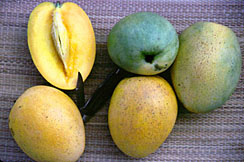 |
Florida | Duncan | ‘Duncan’, of unknown parentage, was one of the few patented varieties of Florida, being bred and protected by David Sturrock of Palm Beach County due to its exceptional production, disease resistance and eating quality. The fruit are oblong and are of uniform shape throughout the canopy, from 16 to 24 oz with an average size of 550 g (19.5 oz). The color is a solid canary yellow with no blush. The skin is thick, waxy and resistant to handling damage, with a soft, tender, and juicy orange flesh. The flesh is velvet-smooth and bright yellow, with an exceptionally sweet, slightly tangy, refreshing flavor reminiscent of ‘Carabao’, with a hint of citrus and a fruity aroma. The fruit ripen in July in Florida and are tolerant of anthracnose infection, making them suitable for production under humid, rainy conditions. Production is heavy. The tree itself is vigorous and open in its growth habit, but highly manageable. It can be maintained at a height and spread of 8 to 10 ft with a minimal of care and pruning. |
| Edward | superb eating quality and a consistent, moderate bearing habit | ||
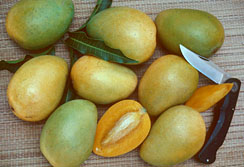 |
Panama | Fairchild | ‘Fairchild’ was selected in the early 1900s in the Panama Canal Zone. It was a favorite of David Fairchild and his family due to its distinctive flavor and heavy production under humid conditions. The small, oblong fruit average 10 oz and are lemon yellow at maturity in June and July. The juicy flesh is deep orange and fiberless, with a rich, aromatic and spicy flavor. %lsquo;Fairchild’ always ranks among the top echelon of cultivars in public evaluations at the Fairchild International Mango Festival. The tree and fruit are highly tolerant of disease and fruit well under humid conditions, making it a natural for South Florida. The tree is among the most ornamental of mangos, with its compact shape and deep green color. It can be maintained at a height and spread of eight feet or less, perfect for those with a modest-sized home garden. |
| Florigon | ‘Florigon’, a pure yellow, early season cultivar with an excellent flavor and good disease tolerance | ||
 |
Florida | Glenn | ‘Glenn’ was discovered as a seedling tree growing at the residence of Mr. Roscoe E. Glenn, Miami, Florida in the 1940s. The fruit are oval to oblong, weighing from 16 to 20 oz with a bright yellow background and a pastel orange-red blush on the shoulders. The deep yellow flesh has no fiber and is soft and silky, with a rich, sweet and aromatic flavor. This is accompanied by a prevalent, sweet aroma. ‘Glenn’ is a favorite in home gardens of Florida because it may be maintained at 10 ft throughout its life with consistent production, disease tolerance and superb eating quality. |
 |
Trinidad | Graham | ‘Graham’ is a descendent of ‘Julie’ selected in Trinidad. The fruit are oval, averaging 13 to 16 oz. The fruit ripen from mid-July to August to a bright yellow, with a slight pink blush. The thick, tough skin conceals a fiberless, deep orange, soft and juicy flesh with a sweet, rich and aromatic flavor. During the late summer, a finer-flavored mango cannot be found. ‘Graham’ grows well in moist, humid conditions, typical of South Florida. The tree is naturally compact, and with annual pruning can be maintained with a size and spread of eight feet, perfect for the space-limited homeowner. |
| Haden | A traditional favorite despite disease susceptibility | ||
 |
Trinidad and Tobago | Ice Cream | ‘Ice Cream’ is small and flattened, weighing 8 oz, with a greenish-yellow color when ready to eat. The skin is thick; yet, tender and easily separating from the fiberless, soft, melting and juicy, yellow flesh. It is the flavor that distinguishes this fruit, with a sweet richness reminiscent of mango sorbet. The fruiting season stretches over a month from June to July. It is perfect for those with limited space or interest in container growing – easily managed to a height of 6 ft. The tree is tolerant of disease, allowing for large harvests with no pesticides. |
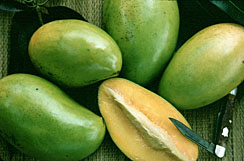 |
India | Imam Pasand | ‘Imam Pasand’ is one of the best mangos of India, ideally suited for dessert, the table and show. The fruit weigh 16 oz or more and are a beautiful smooth oval at maturity. The skin is a dark green, with distinct white highlights over the entire surface. Upon ripening the fruit can attain a deep yellow blush the shoulders and mid-section. The tree has a trailing growth habit and is easily controlled by annual pruning. The properly pruned tree will have a full, spreading canopy of 8 to 10 ft in height and spread. During the fruiting season of June and July, ‘Imam Pasand’ hangs heavy with consistent production. The fruit should be harvested mature green and ripened off the tree at a temperature of 75° to 85° F. Harvesting should occur 2 to 4 weeks before ripening on the tree for the development of the best quality. Properly harvested and ripened fruit have a fiberless, silky flesh with a deep, sweet flavor and distinct citrus overtones. The tree and fruit are tolerant of diseases and require little in the way of special care. |
 |
Jamaica | Julie | ‘Julie’ is synonymous with the Caribbean. Selected in Jamaica, the fruit have a flattened oval shape and are small, generally weighing from 6 to 10 oz. The fruit are greenish to mustard yellow, with a pink blush when exposed to the sun. The deep orange, fiber-free flesh is soft and extremely juicy, with a rich and spicy flavor. The fruit are not stunning specimens, but they certainly have an extraordinary flavor. The fruiting season is from May to July, but unpredictable, with multiple crops throughout the summer. The tree is dwarf and should be grown in combination with other varieties to assure production. |
| Keitt | ‘Keitt’, an excellent late season cultivar with superior quality, manageability, yield and disease tolerance | ||
| Kent | late season mango with good color and exceptional flavor, great for drying | ||
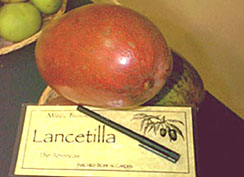 |
Honduras | Lancetilla | ‘Lancetilla’ This impressive mango comes from the north coast of Honduras. The fruit are quite large, ranging from two to five pounds. The thick skin, bright red color with radiant, crimson on the shoulders is tolerant of rough handling and is easily separated from the firm, juicy lemon-yellow flesh. The fiberless flesh is aromatic and has an intensely sweet, flavor. The fruit ripen from mid-August through September, almost the end of the mango season in South Florida. With branch tipping and selective pruning, it can be formed into a small, productive ten-foot tree. ‘Lancetilla,’ with its excellent disease tolerance, is the perfect late season mango, offering beauty, compact size and flavor. |
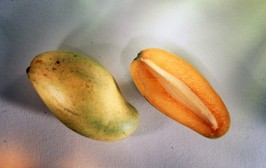 |
Haiti | Madame Francis | ‘Madame Francis’ is a traditional dessert mango from Haiti. The fruit are saber-like in shape, with an undulating and naturally waxed skin. The size of the fruit is from 1 to 1 ½ lb., with a bright yellow color at full maturity. The dark orange somewhat fibrous flesh is soft and juicy with a rich, spicy and sweet flavor that speaks of the Caribbean. ‘Madame Francis’ is one of the few specialty mangos available in the United States for a number of years. The tree is open growing and vigorous, with large, light green leaves and moderate anthracnose tolerance. It is generally one of the first mangos to ripen during the season and often produces multiple crops here in Florida and throughout the tropics. |
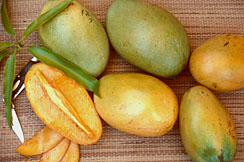 |
India | Mallika | ‘Mallika’ is a hybrid between ‘Neelum’ and ‘Dasheri’, and is considered among the best of the new generation of Indian dessert mangos. The bright yellow fruit are a flattened oblong shape, with a rounded base and an irregular, non-waxy skin, and weigh from 10 to 18 oz. When properly ripened, the pasty, but completely fiber-free flesh is a deep orange, with an intensely sweet, rich and highly aromatic flavor with hints of citrus and melon. ‘Mallika’ fruit are harvested mature-green, before they break color on the tree and should be stored at a temperature of not less than 70°F for 2 to 3 weeks for proper ripening. In this manner their ultimate eating quality will be achieved. The fruit can be refrigerated after complete ripening, but not before. Although best consumed out-of-hand, ‘Mallika’ also excels in juices and as dehydrated slices, with a distinctive honey flavor. ‘Mallika’ receives accolades for flavor among chefs and participants in the Fairchild International Mango Festival. The fruiting season is from late June to July. The tree is semi-dwarf and moderately vigorous, making it attractive to mango growers outside of India, who are always looking for new niche markets around the world. |
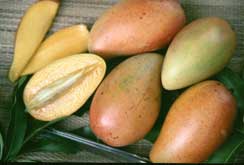 |
Mexico | Manilita | ‘Manilita’ is from the Pacific Coast of Mexico. The fruit are small and elongated, weighing 250 g (9 oz). The color is an eye-catching pastel red, which covers all but the nose of the fruit. The flesh is light yellow and silky-smooth, with a pleasing sweet and uncomplicated flavor. It is perfect for eating out-of-hand, for slicing and dehydrating. The fruit ripen early in the mango season; it is among the earliest red mango to ripen in Florida. The tree is dwarf and disease resistant and is perfectly suited for container or patio production. Tree size can be maintained at 2 m or less in height and 1.5 m in spread. Production is consistent, but modest. |
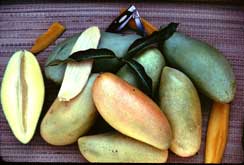 |
Thailand | Nam Doc Mai | ‘Nam Doc Mai’ is among the best known dessert mangos of Thailand, with an exceptional appearance and eating quality. It can sometimes be found in specialty markets in Japan, Europe, and rarely the United States. The fruit are long, slender and sigmoid, weighing from 12 to 16 oz. The ripe fruit range from a greenish- to canary-yellow, rarely with a reddish blush on the sun-exposed shoulder. The fruit are most often eaten when ripe, when the flesh is soft and juicy, with a sweet and aromatic flavor. ‘Nam Doc Mai’, like most Southeast Asian mangos has no fiber. In Thailand and throughout much of Asia, this cultivar encompasses what is most desired in terms of a quality ripe dessert fruit, with a smooth, silky texture and extreme sweetness and bouquet. The fruit are also used while mature green for dipping in sauces and for the making of sweet preserves and pickles. The tree can be pruned to maintain a productive tree of 10 ft or less. It has found a home in the Caribbean, where it grows and fruits well. |
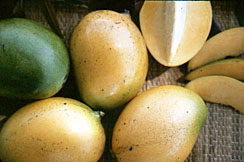 |
India | Neelum | ‘Neelum’ is a South Indian dessert mango, widely grown throughout the country and to an increasing extent in southernmost China. The fruit weigh 9 to 12 oz, with the general shape of a fat cashew nut. They are smooth-skinned and bright yellow upon ripening and have no blush. The flesh is deep yellow or orange. There is no fiber and a rich, aromatic flavor that is over-powering to the unaccustomed palate. ‘Neelum’ is best eaten out-of-hand, or used as slices or cubes in mixed fruit salads, as the firm flesh holds its shape. They have a late ripening season and can be stored for an extended time, which offers advantages in marketing. However, the fruit are only occasionally exported outside of their production areas, due to significant local demand. Fruit should be harvested when mature green and ripened at room temperature off the tree. ‘Neelum’ is a dwarf tree perfect for the home gardener and may fit into modern production systems, which will hopefully increase its availability in commercial export markets. |
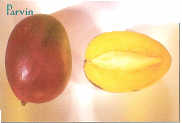 |
Florida | Parvin | ‘Parvin,’ a seedling of ‘Haden,’ was selected in Bradenton, Florida. On the average, the fruit weigh about 19 ounces. They have a heavy wax coating. The skin is an attractive greenish-orange, with a deep red blush extending over all but the nose of the fruit. The deep orange flesh is firm but fiberless — perfect for adding that tropical touch to fruit salads. The flavor is sweet and rich, reminiscent of the cultivar’s ‘Haden’ parent. It ripens in the middle to late season in most climates. The fruit store and ship well. Production is consistent and heavy. The tree can be maintained at 12 feet or less with proper care. ‘Parvin’ often produces seedless fruit that are smaller than normal, but have excellent color and flavor. |
| Thailand | Phimsen Mun | ‘Phimsen Mun’, the premier Thai mango for eating mature green | |
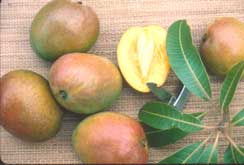 |
Cuba | Prieto | ‘Prieto’ is another heirloom cultivar from Cuba, an island rich in mango diversity. The fruit are small in size, ranging from 8 to 10 oz. The skin color is a dark green – the green so dark in fact that it earned the name “black”, or ‘Prieto’ in Spanish. Beneath this dark green exterior lies a deep orange flesh, and considerable fiber. However, one must not let this stop you. The fruit can be rolled on a table to release the juice for drinking. A rich, sweet and spicy flavor is the reward – well worth the effort to be sure. The tree can be maintained at a height and spread of no more than 12 ft. ‘Prieto’ will not be found in United States or European grocery stores, as it is not exported and is not commonly planted in modern times for commercial use. However, it remains an important local market mango in Cuba and can now it can take a prominent spot in your home garden. |
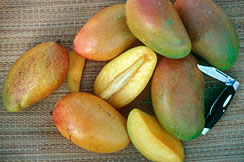 |
Southeast Asia | Rosigold | ‘Rosigold’ is a local selection of Southeast Asian heritage. It is the answer to those who cannot wait for the mango season to arrive – the fruit ripen from middle to late March. The fruit are cylindrical, weighing 11 oz and are a bright yellow, with crimson and red highlights on the sun-exposed shoulders. The skin is thick, tender and adhesive to the soft, melting and juicy deep-orange flesh. The flavor is rich, aromatic and sweet, with a hint of the Asian Tropics. There is no fiber in the silky flesh. The tree is small, manageable and highly productive and can be kept at 8 ft. Blooming often occurs in successive waves throughout the winter, resulting in a multi-harvest fruiting season. There is a need to thin fruit in most years to improve fruit size and quality. |
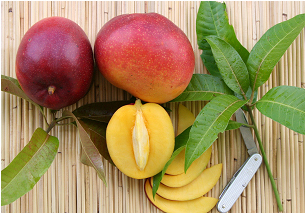 |
Cuba | San Felipe | ‘San Felipe’ is an eye-stopping beauty from western Cuba. Selected in more recent times, ‘San Felipe’ has many characteristics of the ‘Haden’ of Florida. The fruit weight nearly a pound each or slightly more and have a bright yellow background color and an apple-red blush overlaid by a blanket of white dots. The tree is vigorous; yet, productive and consistent in its production. The flesh color is a deep yellow to orange and the flavor is rich, sweet and spicy, one of the classic mango flavors of the world. ‘San Felipe’ is perfect for the home gardener searching for a taste of old Cuba, and bragging rights among his neighbors for the most beautiful of mango fruit. |
 |
Cuba | Toledo | ‘Toledo’ is an heirloom mango from Western Cuba that is still common in local markets throughout the island. The tree is dwarf by nature and can be maintained with a height and spread of less than 8 ft throughout its life. The fruit are small, averaging less than 6 oz. The skin is a speckled greenish-yellow with a slight orange-pink blush. The flesh is fibrous, but the flavor a rich, sweet experience – a true lowland mango experience. ‘Toledo’ typifies the local Caribbean mango, abundant in season and always taken for granted, but when it comes to taste these cultivars may be the best kept secret. ‘Toledo’ will hopefully always hold a place in the tradition and diversity that is Cuba, but just in case, it has a niche in your back yard. |
| Tommy Atkins | the work horse of the home garden in production, reliability and beauty | ||
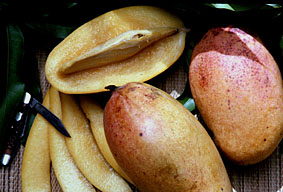 |
Florida | Valencia Pride | ‘Valencia Pride’ is a seedling of Haden which was planted at the residence of Mr. and Mrs. Zapiain of Miami, FL. The tree is vigorous, forming a large, spreading, open canopy of 50 ft. The long, slender fruit have a pronounced S-shape. They are quite large, weighing from 21 to 32 oz. (600 – 900 g). The skin color is striking, having a yellow base color and a vivid crimson to dark red blush. The flesh is firm, melting, and juicy with a mild, and sweet flavor and little fiber. The fruiting season is July to August. This variety is recommended for dooryard planting because of its good eating quality and consistent production. |
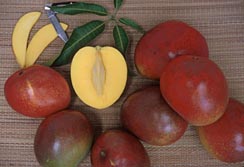 |
Colombia | Vallenato | ‘Vallenato’, from Colombia, which also produces deep red fruit with firm, nearly fiberless, juicy flesh and a rich, sometimes spicy flavor |

